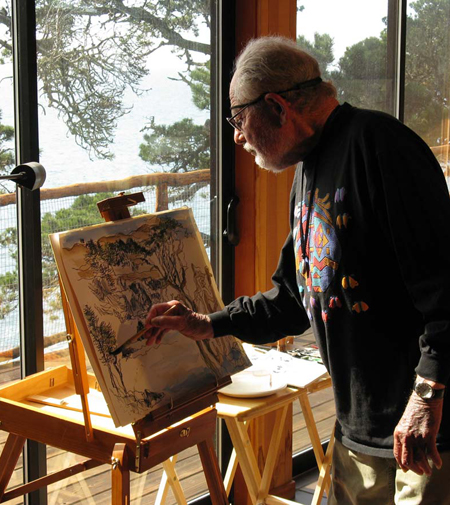Lawrence Halprin’s Evocative Landscapes

“Lawrence Halprin didn’t imitate nature; he abstracted it,” argued Charles Birnbaum, FASLA, president of The Cultural Landscape Foundation (TCLF), at the opening of a new exhibition of Halprin’s work at the National Building Museum in Washington, D.C. Martin Moeller, curator at NBM immediately agreed: Halprin often evoked a natural scene rather than copying it literally. “He let people think it through.”
This well-edited exhibition is perhaps the best of NBM’s recent triptych of landscape architecture exhibitions, which included a survey of the landscape photography of Alan Ward, FASLA, and a retrospective of Oehme van Sweden’s work. The curious flow of the exhibition enables discovery. Around each corner are Halprin’s surprising drawings and dioramas, and photographs graciously donated by some of the country’s leading architectural photographers.
The exhibition moves through 35 sites chronologically, from his early residential work through to his first forays into the public realm, from the hallmarks of his Modernist designs to his post-Modern work in the late 70s and early 80s, and, finally, his capstone projects before his death in 2009.
Some themes emerge. Throughout his career, Halprin enjoyed partnering with artists. He purposefully created room for art works, knowing they add rich, pleasing layers. Gould Garden in Berkeley, California, created from the late 50s to 1960, shows one of his early partnerships with artist Jacques Overhoff, who molded bas-relief panels in concrete around Halprin’s pool.

Halprin believed in cities. When many people abandoned the urban cores after the race riots, Halprin saw opportunities for regrowth. His Portland open space sequence, with its three-part necklace of Modernist parks, was created from 1965-70 and demonstrated his early commitment. Moeller argued “it changed perceptions of downtown Portland.” And New York Times architecture critic Ada Louis Huxtable, who was not generous with the compliments, called the sequence “one of the most important urban spaces since the Renaissance.” (The sequence is now on the National Register of Historic Places, but it is in need of major repair. A $4.5 million rehabilitation effort begins next year).

Halprin was all about “animating the landscape through choreography,” particularly the movement of water. The first thing you see when you enter the exhibition is a 10-foot-tall watercolor drawing of water moving around rocks. But if you look closely, you will see Halprin drew arrows to indicate the currents’ directions; he was mapping the choreography of a shore eddy.
Moeller thinks Halprin was deeply influenced by his wife Anna, who was a dancer. “He adapted her ideas by ‘scoring’ for human activity.” In his UN Plaza in San Francisco, he applied a design approach he called “motation,” which is described in the exhibition as “scoring how perception of the environment changes depending on the speed and motion of the observer.”

The exhibition, of course, includes beautiful photographs of his masterpieces: the Frankin Delano Roosevelt Memorial in Washington, D.C., which is a culmination of his life-long collaboration with artists; Freeway Park in Seattle, which creates a sense of movement through water and sculpted concrete and initiated a new landscape type — the park over a highway; and Sea Ranch in California, which showed how ecological community design should be done.
Sea Ranch in particular is made fresh by new photographs that show how Halprin ingeniously used berms reminiscent of military forts to both hide buildings and pools and create wind blocks. As Birnbaum explained, “Halprin was one of the first to think of landscape as infrastructure.”

Many of Halprin’s landscapes are under threat of demolition or a slow death from a lack of maintenance. Birnbaum hopes this exhibition will help “raise awareness of their value.” It’s a bit ironic given Halprin’s influence can be found in so many contemporary projects. Birnbaum even sees his impact on the High Line in New York City, where James Corner choreographed a continual dance between observer and observed.
The exhibition is open until April 17, 2017. As Birnbaum notes, it will travel to multiple cities, but many of the featured drawings and dioramas won’t; they can only be seen in D.C. Download the gallery guide for free; print copies are available for $12 at the museum and online. Also check out the companion exhibition website from TCLF.
Read Original Article – https://dirt.asla.org/2016/11/04/lawrence-halprins-evocative-landscapes/

